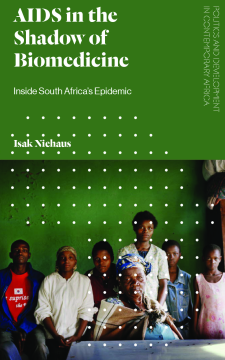
Additional Information
Book Details
Abstract
The Bushbuckridge region of South Africa has one of the highest rates of HIV infection in the world. Having first arrived in the area in the early 1990s, the disease spread rapidly, and by 2008 life expectancies had fallen by 12 years for men and 14 years for women. Since 2005, public health facilities have increasingly offered free HAART (highly active antiretroviral therapy) treatment, offering a degree of hope, but uptake and adherence to the therapy has been sporadic and uneven.
Drawing on his extensive ethnographic research, carried out in Bushbuckridge over the course of 25 years, Isak Niehaus reveals how the AIDS pandemic has been experienced at the village-level. Most significantly, he shows how local cultural practices and values have shaped responses to the epidemic. For example, while local attitudes towards death and misfortune have contributed to the stigma around AIDS, kinship structures have also facilitated the adoption and care of AIDS orphans. Such practices challenge us to rethink the role played by culture in understanding and treating sickness, with Niehaus showing how an appreciation of local beliefs and customs is essential to any effective strategy of AIDS treatment.
Overturning many of our assumptions on disease prevention, the book is essential reading for practitioners as well as researchers in global health, anthropology, sociology, epidemiology and scholars interested in public health and administration in sub-Saharan Africa.
Isak Niehaus is a senior lecturer in anthropology at Brunel University London, where he currently co-ordinates the MSC program in Medical Anthropology. He has previously held teaching positions at the Universities of the Witwatersrand and Pretoria in South Africa, and lectured at several other universities in Europe and the United States. His previous publications include Witchcraft, Power and Politics (co-authored with Eliazaar Mohlala and Kally Shokaneo, 2001) and Witchcraft and a Life in the New South Africa (2012).
‘Niehaus captures the diversity of experiences of those living with HIV/AIDS in Bushbuckridge, South Africa. He reminds us that effective community engagement and efforts to counter stigma must be at the forefront of the global response to HIV/AIDS.’
Peter Piot, London School of Hygiene & Tropical Medicine
‘Building on some three decades of experience, Niehaus offers a superb analysis of the South African HIV/AIDS epidemic. A necessary reminder of how anthropological questions of kinship and misfortune remain highly significant to any understanding of HIV/AIDS.’
Julie Livingston, New York University
‘Niehaus returns us to the fundamentals of anthropology, offering a subtle but sharp critique of the Foucauldian turn in health. This is a superb ethnography – among its contributions the best critique of mainstream views on AIDS orphans I have seen.’
Mark Hunter, author of Love in the Time of AIDS
'A brilliant and vivid ethnographic account of how people’s understanding and treatment of HIV/AIDS intersects with existing social and symbolic meanings around disease, death, witchcraft, healing strategies and everyday social interactions in Bushbuckridge, South Africa.’
Alcinda Honwana, author of Youth and Revolution in Tunisia
Table of Contents
| Section Title | Page | Action | Price |
|---|---|---|---|
| Cover\r | Cover | ||
| About the author | iii | ||
| Title Page | v | ||
| Copyright\r | vi | ||
| Dedication | vii | ||
| Contents | ix | ||
| Maps\r | x | ||
| Preface and acknowledgements | xiii | ||
| 1: Introduction\r | 1 | ||
| Biopolitics and HIV/AIDS | 5 | ||
| From biopolitical theory to social specificity | 10 | ||
| Sickness and AIDS: a brief history of Bushbuckridge | 14 | ||
| Organisation of the book | 24 | ||
| 2: Death\r | 27 | ||
| The sexual hypothesis | 30 | ||
| AIDS as death | 33 | ||
| Stigma of the living corpse | 39 | ||
| Conclusions | 45 | ||
| 3: Blame\r | 47 | ||
| Biomedicine, gender and the politics of blame | 49 | ||
| Conspiracy theories: Dr Wouter Basson, Americans and wild beasts | 55 | ||
| Witchcraft and the reconfiguration of blame | 59 | ||
| Conclusions | 64 | ||
| 4: Words\r | 66 | ||
| ‘If I test HIV-positive I will die’ | 69 | ||
| The agency of words | 72 | ||
| Deadly words, unfortunate names, and curses | 74 | ||
| Sickness, silence and discreet speech | 79 | ||
| Conclusions | 85 | ||
| 5: Knowledge\r | 87 | ||
| Social and material barriers | 89 | ||
| The life story of Reginald Ngobeni | 92 | ||
| Conclusions | 105 | ||
| 6: Dreams\r | 107 | ||
| Experiencing AIDS, using HAART | 110 | ||
| The significance of everyday dreams | 112 | ||
| The content of ARV-induced dreams | 115 | ||
| The sequences of ARV-induced dreams | 124 | ||
| Conclusions | 128 | ||
| 7: Care\r | 130 | ||
| Kinship and the diffusion of parenthood | 134 | ||
| HIV/AIDS and marriage | 138 | ||
| HIV/AIDS and childcare | 140 | ||
| Conclusions | 150 | ||
| 8 Conclusions | 152 | ||
| Culture, South Africa, the baby and the bathwater | 156 | ||
| Beyond biomedicine: therapeutic interventions | 158 | ||
| Notes | 163 | ||
| References | 171 | ||
| Index | 187 |
